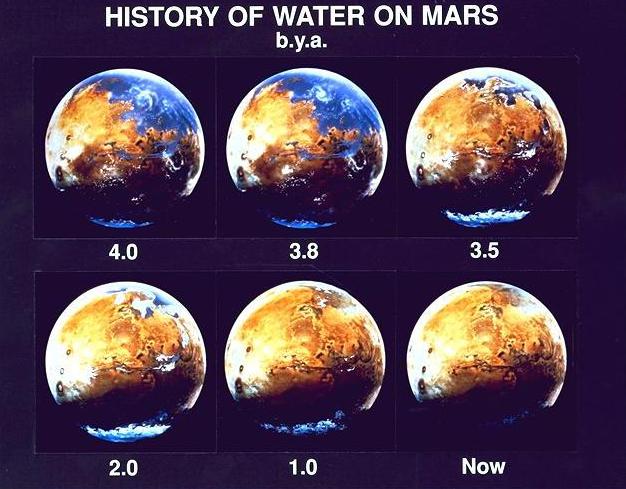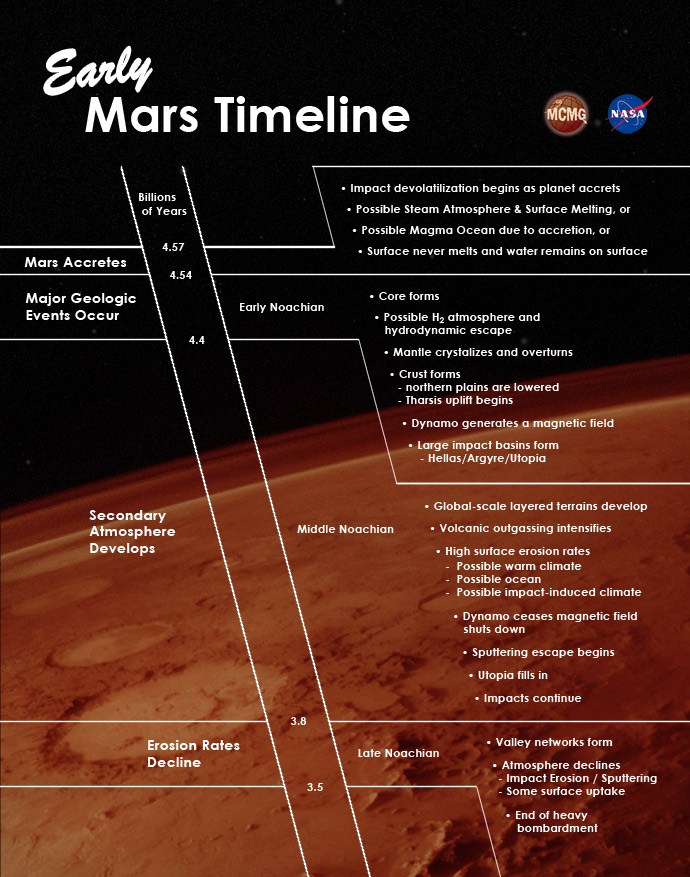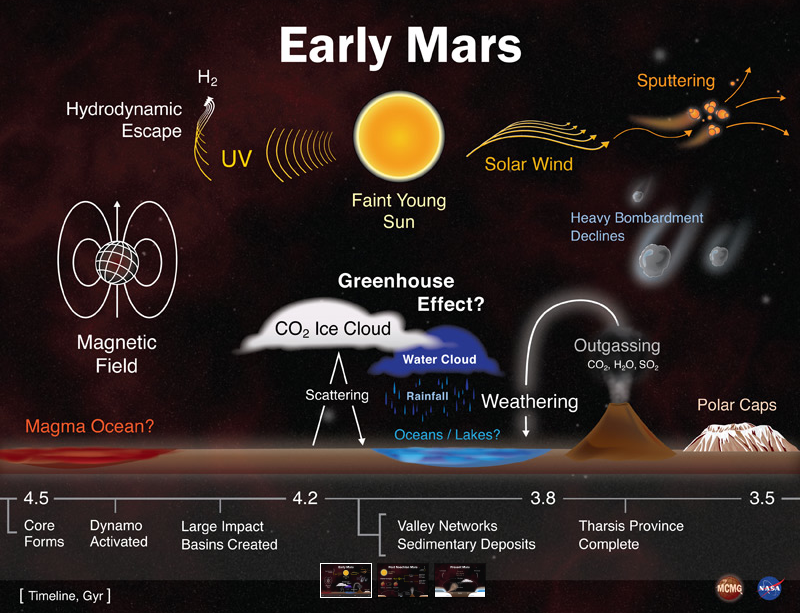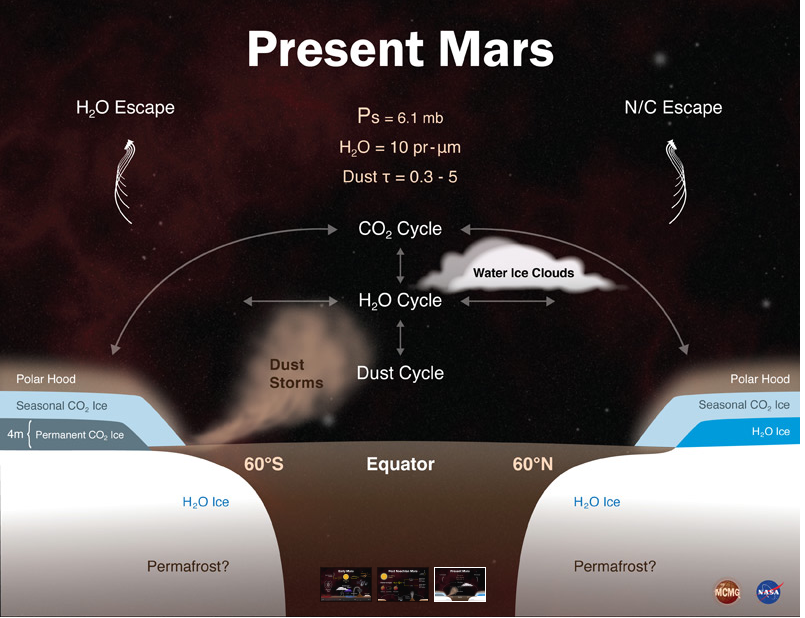It looks like you're using an Ad Blocker.
Please white-list or disable AboveTopSecret.com in your ad-blocking tool.
Thank you.
Some features of ATS will be disabled while you continue to use an ad-blocker.
share:
originally posted by: Thecakeisalie
originally posted by: TruthxIsxInxThexMist
a reply to: 727Sky
Wouldn't tha mean that if we dig down and open this glacier up that it would release 'Oxygen' and 'Carbon dioxide' into Mars's atmosphere??
That could be the start of changing Mars for habitable life!
good news if it can be done
That's the most frustrating thing- We could start the terraforming process within our lifetime- It would be wonderful if we could repurpose nukes to carry payloads of cyanobacteria. sure it might take hundreds of thousands of years but the sooner we start, the sooner we can live there.
An atmosphere is impossible on Mars currently and we have no way to make it possible currently. So it's not possible to even start.
originally posted by: muSSang
originally posted by: TruthxIsxInxThexMist
a reply to: 727Sky
Wouldn't tha mean that if we dig down and open this glacier up that it would release 'Oxygen' and 'Carbon dioxide' into Mars's atmosphere??
That could be the start of changing Mars for habitable life!
good news if it can be done
To much Total Recall for you my friend, without a magnetosphere whatever is released into the atmosphere will slowly be stripped away by the Suns solar rays.
That took millions of years the first time it happened when Mars lost its magnetic field. The Suns solar wind was also a lot stronger then.
FYI: Earth, Venus and Mars are all losing their atmospheres to the solar wind at the roughly the same rate today.
An earthlike Martian atmosphere would be safe for millions of years.
originally posted by: OccamsRazor04
originally posted by: Thecakeisalie
originally posted by: TruthxIsxInxThexMist
a reply to: 727Sky
Wouldn't tha mean that if we dig down and open this glacier up that it would release 'Oxygen' and 'Carbon dioxide' into Mars's atmosphere??
That could be the start of changing Mars for habitable life!
good news if it can be done
That's the most frustrating thing- We could start the terraforming process within our lifetime- It would be wonderful if we could repurpose nukes to carry payloads of cyanobacteria. sure it might take hundreds of thousands of years but the sooner we start, the sooner we can live there.
An atmosphere is impossible on Mars currently and we have no way to make it possible currently. So it's not possible to even start.
Wrong on both points. See my post above this one.
Terraforming Mars is possible with current technology. It would just require centuries to have anything like an earthlike atmosphere.
Read Zubrins books, papers.
edit on 14-9-2015 by JadeStar because: (no reason given)
originally posted by: JadeStar
originally posted by: OccamsRazor04
originally posted by: Thecakeisalie
originally posted by: TruthxIsxInxThexMist
a reply to: 727Sky
Wouldn't tha mean that if we dig down and open this glacier up that it would release 'Oxygen' and 'Carbon dioxide' into Mars's atmosphere??
That could be the start of changing Mars for habitable life!
good news if it can be done
That's the most frustrating thing- We could start the terraforming process within our lifetime- It would be wonderful if we could repurpose nukes to carry payloads of cyanobacteria. sure it might take hundreds of thousands of years but the sooner we start, the sooner we can live there.
An atmosphere is impossible on Mars currently and we have no way to make it possible currently. So it's not possible to even start.
Wrong on both points. See my post above this one.
Terraforming Mars is possible with current technology. It would just require centuries to have anything like an earthlike atmosphere.
Read Zubrins books, papers.
I don't know where you got that from, Mars would have lost it's atmosphere at 10x the rate of Earth.
originally posted by: OccamsRazor04
originally posted by: JadeStar
originally posted by: OccamsRazor04
originally posted by: Thecakeisalie
originally posted by: TruthxIsxInxThexMist
a reply to: 727Sky
Wouldn't tha mean that if we dig down and open this glacier up that it would release 'Oxygen' and 'Carbon dioxide' into Mars's atmosphere??
That could be the start of changing Mars for habitable life!
good news if it can be done
That's the most frustrating thing- We could start the terraforming process within our lifetime- It would be wonderful if we could repurpose nukes to carry payloads of cyanobacteria. sure it might take hundreds of thousands of years but the sooner we start, the sooner we can live there.
An atmosphere is impossible on Mars currently and we have no way to make it possible currently. So it's not possible to even start.
Wrong on both points. See my post above this one.
Terraforming Mars is possible with current technology. It would just require centuries to have anything like an earthlike atmosphere.
Read Zubrins books, papers.
I don't know where you got that from, Mars would have lost it's atmosphere at 10x the rate of Earth.
….in the Early Solar System yes. Our early Sun was a very different star in many ways than the gentle Sun we know today. It put out a lot more atmosphere stripping UV for one thing (SPF 10000 anyone?) and it also put out more charged particles which make up the solar wind. So both the UV and solar wind were stronger when Mars lost its atmosphere
Not today.
So if you could put an Earthlike atmosphere on Mars today, it would persist for millions of years if not a billion.
Here you go: How Vital Is a Planet's Magnetic Field? New Debate Rises
Our nearest planetary neighbors, Mars and Venus, have no oceans or lakes or rivers. Some researchers have speculated that they were blown dry by the solar wind, and that our Earth escaped this fate because its strong magnetic field deflects the wind. However, a debate has arisen over whether a magnetic field is any kind of shield at all.
The controversy stems from recent observations that show Mars and Venus are losing oxygen ions from their atmospheres into space at about the same rate as Earth. This came as something of a surprise, since only Earth has a strong dipolar magnetic field that can prevent solar wind particles from slamming into the upper atmosphere and directly stripping away ions.
"My opinion is that the magnetic shield hypothesis is unproven," said Robert Strangeway from UCLA. "There's nothing in the contemporary data to warrant invoking magnetic fields."
Furthermore here is information on just how long it took Mars to lose its thick atmosphere in the first place:
An illustrated history of Mars and its atmospheric loss.
As you can see the Sun was more active back then with higher UV output and it still took around 300 million years for it to really strip much of the atmosphere once Mars lost its magnetic field. So a terraformed Mars today with a Sun which would be much more friendly to its atmosphere could last 500 million years or more without problem. Plenty of time for any future human settlements to evolve, move on or find a way to generate a planetary magnetic field.
b.y.a = Billion Years




So yes, a Terraformed Mars would be safe.
edit on 14-9-2015 by JadeStar because: (no reason given)
edit on 14-9-2015 by
JadeStar because: (no reason given)
originally posted by: OccamsRazor04
Then we have radiation.
A thicker atmosphere containing ozone would act as a protector against it as it does here on Earth.
originally posted by: JadeStar
….in the Early Solar System yes. Our early Sun was a very different star in many ways than the gentle Sun we know today.
No, that is present levels. The data is from 1998.
science.nasa.gov...
Here is what Zubrin says about radiation.
Furthermore, the International Space Station (ISS) is continuously occupied. That means that while Mars missions are only in space about 40 percent of their mission time, the total GCR dose (measured in person-rems) that the ISS program crews will receive over the next ten years of planned operations is about the same as would be received by a series of five crews of five people each if they launched to Mars every other year over the same period.
www.thespacereview.com...
So you need to rotate 5 crews, rotating every other year.
originally posted by: JadeStar
originally posted by: OccamsRazor04
Then we have radiation.
A thicker atmosphere containing ozone would act as a protector against it as it does here on Earth.
Except Earth has many protective factors Mars would not have.
originally posted by: OccamsRazor04
originally posted by: JadeStar
….in the Early Solar System yes. Our early Sun was a very different star in many ways than the gentle Sun we know today.
No, that is present levels. The data is from 1998.
science.nasa.gov...
It would still take a couple hundred million years for Mars to lose an Earthlike atmosphere at that rate. And the research I quoted was based on data from 1998 but that has not changed. It's still pretty much the same with a little variation due to the 11 year solar cycle.
Here is what Zubrin says about radiation.
Furthermore, the International Space Station (ISS) is continuously occupied. That means that while Mars missions are only in space about 40 percent of their mission time, the total GCR dose (measured in person-rems) that the ISS program crews will receive over the next ten years of planned operations is about the same as would be received by a series of five crews of five people each if they launched to Mars every other year over the same period.
www.thespacereview.com...
So you need to rotate 5 crews, rotating every other year.
I never argued that radiation wouldn't be an issues at Mars today. I am saying that if Mars had an Earthlike atmosphere it would not be an issue.
The radiation on Mars we're talking about is not something internal to Mars, it's solar and cosmic radiation.
A thick earthlike atmosphere would protect against it there just as well as it does here. Of course that would take hundreds of years minimum to even start to achieve any noticible effect on the Martian atmosphere.
Zubrin on Terraforming Mars
Astrobiology Magazine (AM): First off, should Mars be terraformed?
Robert Zubrin (RZ): Yes.
AM: Does Mars contain all of the elements needed to make the planet habitable, or will we have to import gases, chemicals, etc., from elsewhere? If so, then will Mars always need constant inputs to achieve habitability, or do you think that given enough inputs Mars would reach a tipping point and planetary processes would create a self-sustaining feed-back loop?
RZ: It appears that Mars does have all the elements needed for terraforming. The one outstanding question is nitrogen, whose inventory remains unknown. However theory suggests that Mars should have had an initial supply of nitrogen comparable to the Earth, and it seems likely that much of this is still there.
AM: How long will terraforming take? When you envision a terraformed Mars, what do you see?
RZ: If one considers the problem of terraforming Mars from the point of view of current technology, the scenario looks like this:
1. A century to settle Mars and create a substantial local industrial capability and population.
2. A half century producing fluorocarbon gases (like CF4) to warm the planet by ~10 C.
3. A half century for CO2 to outgas from the soil under the impetus of the fluorocarbon gases, thickening the atmosphere to 0.2 to 0.3 bar, and raising the planetary temperature a further 40 C. This will cause water to melt out of the permafrost, and rivers to flow and rain to fall. Radiation doses on the surface will also be greatly reduced. Under these conditions, with active human help, first photosynthetic microbes and then ever more complex plants could be spread over the planet, as they would be able to grow in the open. Humans on Mars in this stage would no longer need pressure suits, just oxygen masks, and very large domed cities could be built, as the domes would no longer need to contain pressure greater than the outside environment.
4. Over a period of about a thousand years, human-disseminated and harvested plants would be able to put ~150 mbar (millibars) of oxygen in the Martian atmosphere. Once this occurs, humans and other animals will be able to live on Mars in the open, and the world will become fully alive.
That’s the scenario, using current technological approaches. However technology is advancing, and 23rd Century humans will not conduct their projects using 21st Century means. They will use 23rd Century means and accomplish the job much faster than anyone today can suppose.
So if someone in the 24th Century, living on a fully terraformed Mars, should discover this interview, I believe that she will view it in much the same way as we today look at Jules Verne’s lunar mission design. We today look at Verne’s ideas and say “Amazing, a man living a hundred years before Apollo foresaw it — and not only that– launched his crew of three from Florida, and returned them in a capsule landing in the Pacific Ocean where they were picked up by a US warship, all as things actually happened. But launching people with heavy artillery – how 19th Century can you get?” So our 24th Century Martian historian studying this interview will smile and say; “Incredible. Here are people 300 years ago talking about terraforming Mars. But doing it with fluorocarbon gases and green plants –how 20th century can you get?”
edit on 14-9-2015 by JadeStar
because: (no reason given)
edit on 14-9-2015 by JadeStar because: (no reason given)
A study by Mertens of polar flights during a solar storm in 2003 showed that passengers received about 12 percent of the annual radiation limit recommended by the International Committee on Radiological Protection. The exposures were greater than on typical flights at lower latitudes, and confirmed concerns about commercial flights using polar routes.
www.nasa.gov...
One flight, 12% of the yearly limit, because the poles have a weak magnetosphere. Imagine that all year long, up to 1000x higher than what you would get with a strong magnetosphere.
originally posted by: OccamsRazor04
A study by Mertens of polar flights during a solar storm in 2003 showed that passengers received about 12 percent of the annual radiation limit recommended by the International Committee on Radiological Protection. The exposures were greater than on typical flights at lower latitudes, and confirmed concerns about commercial flights using polar routes.
www.nasa.gov...
One flight, 12% of the yearly limit, because the poles have a weak magnetosphere. Imagine that all year long, up to 1000x higher than what you would get with a strong magnetosphere.
Most plans for Mars bases, settelments, colonization call for habitats to be burried or even constructed underground.
No one is seriously considering living on the surface of Mars at present. Like Zubrin says, the first thing you do when you get to Mars is dig.
originally posted by: JadeStar
originally posted by: OccamsRazor04
A study by Mertens of polar flights during a solar storm in 2003 showed that passengers received about 12 percent of the annual radiation limit recommended by the International Committee on Radiological Protection. The exposures were greater than on typical flights at lower latitudes, and confirmed concerns about commercial flights using polar routes.
www.nasa.gov...
One flight, 12% of the yearly limit, because the poles have a weak magnetosphere. Imagine that all year long, up to 1000x higher than what you would get with a strong magnetosphere.
Most plans for Mars bases, settelments, colonization call for habitats to be burried or even constructed underground.
No one is seriously considering living on the surface of Mars at present. Like Zubrin says, the first thing you do when you get to Mars is dig.
If you are saying we could live underground I agree, no need for atmosphere if you are buried though.
originally posted by: OccamsRazor04
originally posted by: JadeStar
originally posted by: OccamsRazor04
A study by Mertens of polar flights during a solar storm in 2003 showed that passengers received about 12 percent of the annual radiation limit recommended by the International Committee on Radiological Protection. The exposures were greater than on typical flights at lower latitudes, and confirmed concerns about commercial flights using polar routes.
www.nasa.gov...
One flight, 12% of the yearly limit, because the poles have a weak magnetosphere. Imagine that all year long, up to 1000x higher than what you would get with a strong magnetosphere.
Most plans for Mars bases, settelments, colonization call for habitats to be burried or even constructed underground.
No one is seriously considering living on the surface of Mars at present. Like Zubrin says, the first thing you do when you get to Mars is dig.
If you are saying we could live underground I agree, no need for atmosphere if you are buried though.
Agreed. However I look at Mars settlement as a long term thing so while everyone might in the near term live in tin cans and then domes underground at the same time automated things could be going on on the surface to help terraform the planet for surface habitation in 1,000 years.
They're not mutually exclusive but yes, when we first go there we'll be burying our habs.
edit on 15-9-2015 by JadeStar because: (no reason
given)
originally posted by: UnBreakable
I guess there's no global warming on Mars.
Nope but we if we could start doing that there it would be beneficial to the planet's climate in the distant future.
originally posted by: OccamsRazor04
a reply to: JadeStar
Even in 1,000 years, with no magnetosphere, the surface would not be a hospitable place. Not instant death, but you would not be taking long walks.
Of course not but it would be habitable, warmer, wetter. Again, terraforming would be a long term project with a long term view. 1,000 years would be the very beginning of surface habitation but things would improve from there as the atmosphere thickened.
a reply to: OccamsRazor04
You so are simply wrong on all points
We do have the tech to reach and start terraforming mars
It's not rocket science
Listen to jade . Watch the video I posted
It may take a thousand years or more to do it but I can happen
And that's based on old tech
What we come up with in 100 years will radically alter that time frame
You so are simply wrong on all points
We do have the tech to reach and start terraforming mars
It's not rocket science
Listen to jade . Watch the video I posted
It may take a thousand years or more to do it but I can happen
And that's based on old tech
What we come up with in 100 years will radically alter that time frame
new topics
-
Shane Gillis commercial
Jokes, Puns, & Pranks: 2 minutes ago -
Elon Says It’s ‘Likely’ He Buys Tanking MSNBC
Political Ideology: 2 hours ago -
Montelukast affects brain, caused 5 year old to attempt suicide
Medical Issues & Conspiracies: 3 hours ago -
Jaguar Rebrand Video Causes "WTF?" Moment - Seriously Weird
Automotive Discussion: 5 hours ago -
Let's start a conspiracy
General Conspiracies: 5 hours ago -
What Joe Rogan said Vs The View
Dissecting Disinformation: 8 hours ago -
Biden's "Reckless" Decision To Escalate Russia-Ukraine War
World War Three: 9 hours ago
top topics
-
Biden's "Reckless" Decision To Escalate Russia-Ukraine War
World War Three: 9 hours ago, 16 flags -
Jaguar Rebrand Video Causes "WTF?" Moment - Seriously Weird
Automotive Discussion: 5 hours ago, 13 flags -
What Joe Rogan said Vs The View
Dissecting Disinformation: 8 hours ago, 11 flags -
Montelukast affects brain, caused 5 year old to attempt suicide
Medical Issues & Conspiracies: 3 hours ago, 9 flags -
Elon Says It’s ‘Likely’ He Buys Tanking MSNBC
Political Ideology: 2 hours ago, 9 flags -
Inca stone masonry at Sacsayhuaman, Ollantaytambo and the Sun Temple
Ancient & Lost Civilizations: 17 hours ago, 7 flags -
Let's start a conspiracy
General Conspiracies: 5 hours ago, 1 flags -
Shane Gillis commercial
Jokes, Puns, & Pranks: 2 minutes ago, 0 flags
active topics
-
Elon Says It’s ‘Likely’ He Buys Tanking MSNBC
Political Ideology • 42 • : CarlLaFong -
Biden's "Reckless" Decision To Escalate Russia-Ukraine War
World War Three • 109 • : Oldcarpy2 -
Shane Gillis commercial
Jokes, Puns, & Pranks • 0 • : theatreboy -
Well we know Putins ICBMs won't fail in their silos
World War Three • 168 • : NoCorruptionAllowed -
What Joe Rogan said Vs The View
Dissecting Disinformation • 18 • : bluesman023 -
Jaguar Rebrand Video Causes "WTF?" Moment - Seriously Weird
Automotive Discussion • 14 • : bluesman023 -
A Mysterious Orb filmed over NYC by local news
Aliens and UFOs • 22 • : lostgirl -
FEMA Head Admits Agency Skipped 20 Homes with Trump Signs
Mainstream News • 19 • : NorthOS -
Gaetz withdraws from attorney general consideration
US Political Madness • 25 • : bluesman023 -
Is Russia Using a New Type of Beam Weapon Against Ukraine?
Weaponry • 21 • : Ravenwatcher
